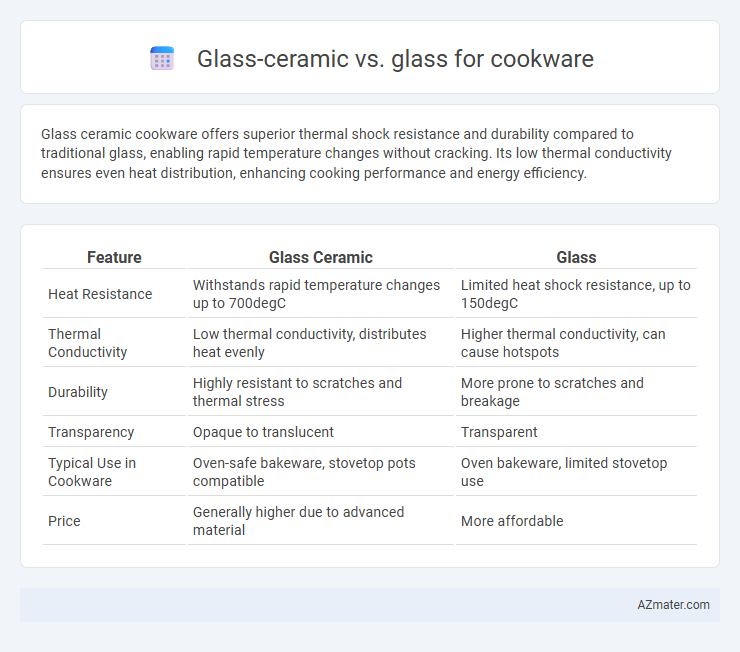Glass ceramic cookware offers superior thermal shock resistance and durability compared to traditional glass, enabling rapid temperature changes without cracking. Its low thermal conductivity ensures even heat distribution, enhancing cooking performance and energy efficiency.
Table of Comparison
| Feature | Glass Ceramic | Glass |
|---|---|---|
| Heat Resistance | Withstands rapid temperature changes up to 700degC | Limited heat shock resistance, up to 150degC |
| Thermal Conductivity | Low thermal conductivity, distributes heat evenly | Higher thermal conductivity, can cause hotspots |
| Durability | Highly resistant to scratches and thermal stress | More prone to scratches and breakage |
| Transparency | Opaque to translucent | Transparent |
| Typical Use in Cookware | Oven-safe bakeware, stovetop pots compatible | Oven bakeware, limited stovetop use |
| Price | Generally higher due to advanced material | More affordable |
Introduction to Cookware Materials
Glass ceramic cookware offers superior thermal shock resistance compared to traditional glass, enabling rapid temperature changes without cracking. Glass ceramic materials contain crystalline structures that provide enhanced durability and heat distribution, ideal for stovetop and oven use. In contrast, standard glass cookware is more prone to breakage under direct heat but excels in microwave safety and clarity for visual cooking monitoring.
What is Glass Ceramic?
Glass ceramic is a specialized material engineered through controlled crystallization of glass, resulting in a durable, heat-resistant surface ideal for cookware. Unlike traditional glass, glass ceramic combines the clarity and smoothness of glass with enhanced thermal shock resistance, allowing it to withstand rapid temperature changes without cracking. This makes glass ceramic cooktops and bakeware highly efficient and reliable for precise cooking applications.
What is Traditional Glass?
Traditional glass cookware is made from non-porous, silica-based materials that offer moderate heat resistance but can be prone to thermal shock and breakage under rapid temperature changes. Glass ceramic, conversely, is engineered with crystalline structures that allow superior heat tolerance and durability, enabling it to withstand direct stovetop cooking and sudden temperature shifts without cracking. While traditional glass is ideal for oven and microwave use due to its transparency and non-reactive nature, glass ceramic provides enhanced versatility and longevity for various cooking methods.
Heat Resistance: Glass Ceramic vs Glass
Glass ceramic cookware offers superior heat resistance compared to regular glass, withstanding temperatures up to 1400degF (760degC) without cracking or warping. In contrast, standard glass cookware typically tolerates temperatures only up to 575degF (300degC) before risk of breakage increases. This enhanced thermal durability makes glass ceramic ideal for high-heat cooking methods and rapid temperature changes.
Durability and Strength Comparison
Glass ceramic cookware offers superior durability and strength compared to traditional glass cookware, resisting thermal shock up to 572degF (300degC) without cracking. Glass ceramic materials feature a crystalline structure that enhances impact resistance and prevents shattering under rapid temperature changes. In contrast, conventional glass cookware is more prone to breaking due to lower tolerance for thermal stress and mechanical impact.
Usability on Various Heat Sources
Glass ceramic cookware withstands rapid temperature changes and performs efficiently on electric, gas, and induction cooktops due to its high thermal shock resistance. Traditional glass cookware is suitable primarily for oven use and low to moderate heat but is incompatible with induction stoves and can crack under sudden temperature shifts. Choosing glass ceramic ensures broader usability across diverse heat sources, enhancing cooking flexibility and durability.
Thermal Shock Resistance
Glass ceramic cookware exhibits superior thermal shock resistance compared to traditional glass cookware, allowing it to withstand rapid temperature changes without cracking or breaking. This property is due to its unique crystalline structure formed during controlled crystallization, which provides enhanced durability and stability under extreme heat fluctuations. As a result, glass ceramic cookware is ideal for tasks involving abrupt transitions between stovetop and oven or freezer to oven.
Maintenance and Cleaning Ease
Glass ceramic cookware offers superior ease of maintenance due to its non-porous surface that resists staining and reduces the buildup of burnt-on residue, allowing for quick and effective cleaning with mild detergents. In contrast, traditional glass cookware is more prone to scratches and surface damage, which can trap food particles and stains, making thorough cleaning more challenging over time. The durability of glass ceramic materials also supports frequent dishwasher use without compromising cookware integrity, enhancing long-term cleanliness and convenience.
Price and Availability
Glass ceramic cookware typically costs more than regular glass cookware due to its enhanced durability and heat resistance. Glass cookware is widely available in most kitchenware stores and online, offering a budget-friendly option for everyday cooking needs. The higher price of glass ceramic products reflects their specialized manufacturing process and ability to withstand extreme temperature changes without cracking.
Choosing the Right Material for Your Cookware
Glass ceramic cookware offers superior heat resistance and even heat distribution compared to regular glass, making it ideal for consistent cooking results. It withstands sudden temperature changes without cracking, whereas standard glass is more prone to thermal shock and breakage. Choosing glass ceramic ensures durability and versatility, while glass cookware is generally more affordable but less robust for high-heat applications.

Infographic: Glass ceramic vs Glass for Cookware
 azmater.com
azmater.com